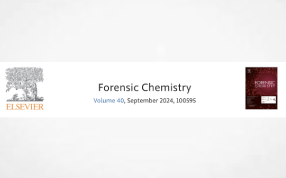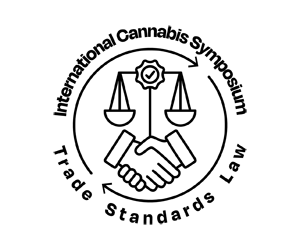Thanks to Lex Pelger’s Newsletter for the tip
Highlights
- •
An LC-HRMS method was validated for the determination of Δ9-THCP in retail samples.
- •
Δ9-THCP was quantified in cannabis flower, gummies, and a vape cartridge.
- •
Untargeted cannabinomics was applied for the tentative identification of unknown compounds.
- •
Hydrogenated, esterified, and acetylated derivatives of cannabinoids were detected.
Abstract
Δ9-Tetrahydrocannabinol (Δ9-THC) is known to be the component of the cannabis plant responsible for the psychoactive effects generated by the activation of the endocannabinoid receptor 1 (CBR1). Following extensive structure–activity relationship (SAR) studies on Δ9-THC, new molecules with increased CBR1 affinity were designed and synthesized over the last decades. The knowledge arising from the pharmacological and synthetic investigations has been extensively used in the recent past by the industry of substances for recreational use also thanks to the 2018 Farm Bill Act in the USA and the incentive for low-THC cannabis (hemp) cultivation in Europe, which have boosted the availability of hemp derived precursors.
As a result, new semi-synthetic natural and pseudo natural cannabinoids related to the most famous Δ9-THC and often not subjected to legal restrictions are now available in the online market in a broad array of retail products with no preventive study on their pharmacodynamics and pharmacokinetics.
Some of these products (gummies, cannabis flower and a vape cartridge), all declared to contain the most potent among all the known cannabinoids, Δ9-Tetrahydrocannabiphorol (Δ9-THCP), were bought from an online shop and tested through LC-HRMS to determine the effective amount of Δ9-THCP and of other cannabinoids.
All the three samples were found to contain Δ9-THCP in amounts significantly different from those declared by the producer. Moreover, the application of an untargeted metabolomics approach (cannabinomics) enabled the identification of other cannabinoids including the emerging semi-synthetic hexahydrocannabinol (HHC) and tetrahydrocannabidiol (H4-CBD) together with byproducts of synthetic origin.
Graphical abstract
Introduction
Δ9-Tetrahydrocannabinol (Δ9-THC) (Fig. 1) is the primary psychoactive component of cannabis (Cannabis sativa L.) responsible for the “high” effects achieved by stimulating specific receptors in the central nervous system (CNS) called endocannabinoid receptors (CBR). In particular, the cascade of effects produced by the stimulation of the endocannabinoid receptor 1 (CB1R) consists of alteration of neurotransmitter functionality, enzyme activity, prostaglandin synthesis, membrane perturbation, and so forth and it is translated into various effects such as CNS depression, ataxia, psychoactive effects, hypothermia, analgesia, cardiovascular effects, and more [1]. Following its discovery in 1964 by Raphael Mechoulam [2], the pharmacological behaviour of Δ9-THC has increasingly attracted the attention of researchers and industries, but also of recreational drug users seeking the psychoactive effects ascribed to this compound.
Extensive structure–activity relationship (SAR) studies on the THC molecule were conducted since the early 1970s by Mechoulam and Edery, highlighting the importance of the aliphatic side chain attached to the resorcinol moiety for the affinity to CB1R [3]. Specifically, the side chain of Δ9-THC is linear and contains five carbon atoms, but it was shown to retain its psychoactive activity with at least three carbon atoms. Importantly, an increasing number of carbons in the side chain was found to confer higher potency [1].
Besides the numerous synthetic variations of the lead compound with the aim of enhancing the affinity for CB1R and, consequently, the cannabimimetic activity, up to few years ago Δ9-THC was believed to be the sole naturally occurring molecule to exert the “cannabis-like” effects. Only Δ8-THC, produced by the thermodynamic degradation of Δ9-THC, showed similar psychoactive activity. The other two mildly psychoactive compounds known were Δ9-tetrahydrocannabivarin (Δ9-THCV) and cannabinol (CBN), the propyl homologue and the oxidation product of Δ9-THC, respectively (Fig. 1). However, Δ9-THCV exhibited lower affinity for CB1R compared to Δ9-THC (Ki = 75.4 nM vs 39.5 nM) [4], although higher than CBN, which resulted 2–4 times lower compared to that of Δ9-THC (Ki = 211.2 ± 35.0 nM vs 80.3 ± 22.2 nM) [5]. No other molecules with a longer or branched side chain were known in the plant.
In the past five years, three Δ9-THC homologues with a linear alkyl side chain were discovered in the cannabis plant: Δ9-tetrahydrocannabutol (Δ9-THCB) [6], Δ9-tetrahydrocannabihexol (Δ9-THCH) [7], and Δ9-tetrahydrocannabiphorol (Δ9-THCP) [8], respectively the butyl, hexyl, and heptyl homologue of Δ9-THC (Fig. 1). Only Δ9-THCB and Δ9-THCP were evaluated for their CB1R affinity as Δ9-THCH was found in very low amount in cannabis. In details, Δ9-THCB showed an in vitro CB1R affinity 3-fold higher than Δ9-THC (Ki = 15 nM vs 40 nM) and an in vivo cannabimimetic activity similar to that of the latter [6]. Surprisingly, Δ9-THCP showed a 33-fold higher affinity for CB1R compared to Δ9-THC (Ki = 1.2 nM vs 40 nM) and an in vivo full-agonist behaviour at the same dose of Δ9-THC (10 mg/kg) [8].
The discovery of Δ9-THCP has revolutionized the knowledge around the cannabis chemistry and phytocannabinoid biosynthesis, but has also captured the interest of various industries devoted to the development of recreational cannabis derived products. Notwithstanding Δ9-THC and Δ8-THC are Schedule I substances under the 1971 Convention on Psychotropic Substances, Δ9-THCP has not been examined by the international authorities in these terms and is openly sold as a hemp derived legal product. Indeed, the 2018 Farm Bill Act in the USA has established a clear boundary of legality for all compounds that can be derived from cannabidiol (CBD), which is the main non-psychoactive component of hemp [9]. Under this act, all phytocannabinoids different from Δ9-THC naturally occurring in hemp, although in trace amounts, are considered legal and can be included in commercial products regardless of their actual concentration. On the other hand, in Europe there is still silence on this matter, thus Δ9-THCP can be found all over the world in several recreational products.
Marketed THCP products include either Δ8 or Δ9 forms, which are probably synthetically produced given their low concentration in cannabis plants [10].
A few years after the discovery of Δ9-THCP, a cannabinoid claimed to be hemp-derived started to spread in the USA and Europe: hexahydrocannabinol (HHC), the hydrogenated derivative of Δ8– and Δ9-THC (Fig. 1) [11], [12]. Such cannabinoid is able to provide similar psychoactive effects as Δ9-THC with the (9R) epimer being the active form and the (9S) the less active as suggested by in vitro radioligand assay at CB1R (Ki = 15 nM and 176 nM for the (9R) and the (9S) form respectively) and in vivo experiments [13], [14], [15], [16]. It has been reported that HHC is obtained by semi-synthesis from the conversion of CBD into either Δ8– or Δ9-THC and subsequent hydrogenation and that the active epimer (9R) is preferably obtained via the Δ8-THC intermediate [15], [17].
If residual CBD is present during the hydrogenation of THC it can be completely hydrogenated to tetrahydrocannabidiol (H4-CBD) [18]. Otherwise, if the reaction conditions are not suitable to ensure complete hydrogenation, the reaction leads to the formation of partially hydrogenated CBD derivatives. Hence, it is possible to hypothesize that commercial products containing H4-CBD (whether declared or not) may also contain the three forms of H2-CBD as impurities. Ben Shabat et al. observed that incomplete hydrogenation leads to a mixture containing both epimers (at the C3) of the derivative obtained by hydrogenation of the C3-C2 double bond and the isomer obtained by hydrogenation of the C8-C9 double bond, with a marked prevalence of the latter [19]. This latter form of H2-CBD has shown to possess its own pharmacodynamics with interesting properties in the treatment of skin disorders, as well as antibacterial, bactericidal, antioxidant activity and lower toxicity to human skin fibroblasts compared to the parent compound CBD [20], [21].
An obvious outcome of the widespread marketing of THCP and HHC is now represented by hexahydrocannabiphorol (HHCP), obtained from the hydrogenation of THCP with the same stereochemical implications as HHC. Very little knowledge has been shared around HHCP and very recently the isolation and identification of the components and stereoisomers has been reported in two types of e-cigarette cartridges containing HHC or HHCP using NMR spectroscopy [22]. Moreover, the authors combined three techniques, NMR, GC–MS, and LC-QToF-MS, to identify the unknown components, which included 11α-HHC, 11β-HHC, dihydro-iso-THC, 11α-HHCP, and 11β-HHCP [22]. Dihydro-iso-THC most likely derives from the hydrogenation of Δ8–iso-THC and Δ4(8)–iso-THC, which are obtained during the acid-catalysed cyclization of CBD along with the major products Δ8– and Δ9-THC [22], [23].
It should be taken into account, however, that each time a synthetic reaction is involved in the production route, safety concerns are raised for the potential contaminants in the final products. Indeed, these contaminants can include not only understudied or unknown cannabinoids but also other reaction side products, raising the possibility of unknown pharmacological and toxicological profiles.
From the analytical point of view, in a perspective of quality control, the presence of all these byproducts from synthetic reactions or of minor cannabinoids from hemp derived raw materials is a challenge because of the lack of the corresponding analytical standards for positive identification using common MS techniques.
To further complicate this scenario pesticides, heavy metals, and excipients are not generally assessed by manufacturers [14]. It should be also noted that most CBD-derived products may contain over the limit Δ9-THC levels as reaction side products [14], [15].
All these new compounds are sold as exotic cannabinoids in a wide range of commercial products including tinctures, distillates, vape cartridges, gummies as well as spiked on cannabis inflorescence [24]. Sometimes these products may be purchased accompanied by a certificate of analysis dealing merely with the concentration of the main active compound or the percentage of Δ9-THC (for legal requirements) but all the aforementioned contaminants are not reported. Beside this, all both known and unknown cannabinoids can be present at remarkable concentrations with consequent unpredictable side effects. Indeed, unlike the common synthetic cannabinoids, which are known among users to cause serious side effects, these pseudo-natural exotic cannabinoids claim to have the same beneficial effects of cannabis and are masked under the alleged legality of hemp that can be misinterpreted for harmlessness.
The lack of knowledge on the real content of these recreational retail products and of scientific research on the pharmacology of all these new cannabinoids, together with the simultaneous uncontrolled spreading of their recreational use, pose a serious risk for public health and safety. Hence, the purpose of this article is to disseminate what emerged from the analysis of some freely available products purchased online and advertised to contain Δ9-THCP. Samples of gummy candies, vape cartridge, and Δ9-THCP-based inflorescences were analyzed using high performance liquid chromatography coupled with high-resolution mass spectrometry (LC-HRMS) to determine their content of Δ9-THCP and other natural and synthetic cannabinoids, thereby verifying the accuracy of the labeling.





















